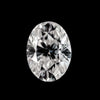
What is SI2 Clarity in a Diamond: Understanding the Clarity Grade
When we examine diamonds, one of the key aspects that affects both their aesthetics and value is the clarity grade, which assesses the visual appearance of natural imperfections found within the gem. SI2 clarity falls within the clarity grading scale established by the Gemological Institute of America (GIA). In this grade, the "SI" stands for "Slightly Included," which refers to the presence of inclusions that are noticeable under 10x magnification but are often not visible to the unaided eye.
Understanding SI2 clarity helps us make informed decisions when purchasing a diamond. An SI2 diamond will typically have more inclusions than those found in higher clarity grades, yet these inclusions can often be strategically positioned or sized in such a way that they're less noticeable once the diamond is set in jewelry. Pricing for SI2 diamonds reflects their place on the clarity spectrum, presenting an appealing balance for those of us seeking larger or better-color diamonds within a given budget.
Understanding SI2 Clarity
When we discuss SI2 clarity, we delve into one of the nuances of the diamond's visual traits—specifically, its inclusions and blemishes at a very particular ranking on the clarity scale.
Diamond Clarity Scale
The diamond clarity scale is a crucial framework we use to evaluate the presence of internal and external imperfections, known as inclusions and blemishes, respectively. The Gemological Institute of America (GIA) developed this universally accepted grading system that classifies diamonds based on their clarity characteristics. The scale comprises several grades:
- Flawless (FL): No inclusions or blemishes visible under 10x magnification.
- Internally Flawless (IF): No inclusions and only insignificant blemishes visible under 10x magnification.
- Very, Very Slightly Included (VVS1 and VVS2): Inclusions are difficult to see under 10x magnification.
- Very Slightly Included (VS1 and VS2): Inclusions are visible with effort under 10x magnification, but can be characterized as minor.
- Slightly Included (SI1 and SI2): Inclusions are noticeable under 10x magnification.
- Included (I1, I2, and I3): Inclusions are obvious under 10x magnification which may affect transparency and brilliance.
SI2 Clarity Explained
SI2 stands for Slightly Included 2, which is a particular grade within the diamond clarity scale where inclusions are noticeable to a trained eye using 10x magnification. At the SI2 clarity level, inclusions might also be visible to the naked eye, depending on the size, nature, and location of these imperfections within the diamond. These inclusions can take various forms such as crystals, feathers, or clouds.
It's important to consider that while SI2 clarity diamonds do possess inclusions, these inclusions are often not detrimental to the diamond's overall appearance, especially when it is properly cut and set in jewelry. SI2 clarity diamonds offer a balance between aesthetic appeal and cost, often providing good value for those prioritizing size and price over a flawless appearance.
Evaluating SI2 Diamonds

When considering SI2 diamonds, it's crucial to understand their clarity characteristics and how they stack up against other diamonds in the clarity scale created by the Gemological Institute of America (GIA).
SI2 Clarity Characteristics
SI2 stands for "Slightly Included 2" and represents a clarity grade in which inclusions are noticeable under 10x magnification. When we examine SI2 diamonds, we often observe inclusions that could be visible to the naked eye, especially when viewed from above. These flaws can vary in size, number, and location, but they do not generally compromise the structural integrity of the diamond. To accurately assess these inclusions, we consult with certified gemologists who are skilled in diamond grading.
- Visibility of Inclusions: SI2 diamond inclusions may be visible without magnification depending on the nature and location of the flaws.
- Inclusion Type: The inclusions in an SI2 diamond can take the form of clouds, feathers, or crystals.
Comparison to Other Clarity Grades
SI2 diamonds are positioned toward the lower end of the clarity scale, just above I1, I2, and I3 grades, which contain inclusions that often affect the diamond's beauty and durability. In contrast, SI1 clarity diamonds have fewer and smaller inclusions compared to SI2. Moving up the scale, VS2 (Very Slightly Included 2) diamonds will have minor inclusions that are less visible than those found in SI2 diamonds. The VS1, VVS2 (Very Very Slightly Included 2), VVS1, FL (Flawless), and IF (Internally Flawless) grades indicate even fewer and smaller inclusions, often invisible to the naked eye and sometimes even under magnification.
Clarity Grade Comparison:
- SI1: Less and smaller inclusions than SI2
- VS2: Less visible inclusions compared to SI2
- VS1, VVS2, VVS1: Inclusions often invisible to the naked eye
- IF, FL: No inclusions or surface blemishes visible under magnification
When we assess SI2 diamonds against these other clarity grades, price and appearance factors come into play; SI2 diamonds can offer a balance for those who prioritize size and cost over perfect clarity. To make an informed purchase, we always recommend examining the diamond closely, preferably with the help of a gemologist, to understand the exact nature of the inclusions within the stone.
Visual Appeal of SI2 Clarity Diamonds

In evaluating SI2 clarity diamonds, we recognize two essential factors: how inclusions affect appearance under magnification and to what extent a diamond may appear eye-clean.
Appearance Under Magnification
When we inspect SI2 diamonds under magnification, we often find various inclusions such as clouds, feathers, or crystals. At 10x magnification, which is the standard for diamond grading, these imperfections are typically noticeable. However, it's important to note that the size, color, number, and location of the inclusions greatly influence their visibility. Moreover, while magnification reveals these blemishes, it does not necessarily reflect their impact on the diamond's overall brilliance and sparkle.
Eye-Clean SI2 Diamonds
An "eye-clean" SI2 diamond is one where inclusions are undetectable to the naked eye when viewed from about 6 inches away. We understand that finding an eye-clean SI2 can be subjective as it depends on individual eyesight and the observer's experience. The diamond's cut also plays a crucial role; a well-cut diamond can mask certain imperfections, thus enhancing its visual appeal. While not all SI2 diamonds qualify as eye-clean, those that do often present a balance of beauty and value, maintaining an appealing sparkle and brilliance without noticeable flaws at a glance.
Factors Affecting the Value of SI2 Diamonds
Cut Quality
💎 Cut quality significantly influences the brilliance and value of an SI2 diamond.
Clarity Grade
🔍 SI2 diamonds have slight inclusions visible under magnification, affecting their value.
Color Grade
🌈 The colorlessness of an SI2 diamond impacts its visual appeal and value.
Carat Weight
⚖️ Larger carat weight increases the rarity and value of an SI2 diamond.
In our examination of SI2 clarity diamonds, we focus on how specific characteristics such as size and color, as well as the craftsmanship of the cut, significantly influence their value.
Influence of Size and Color
When evaluating SI2 clarity diamonds, we notice that size and color have a pronounced impact on value. An increase in carat size typically amplifies the visibility of inclusions, which can affect the diamond's appeal and price. Conversely, smaller SI2 diamonds may have inclusions that are less noticeable, thereby holding better value relative to their size.
In terms of color, diamonds with a high color grade (closer to D, which is colorless) can mitigate the appearance of inclusions. Therefore, a high color grade paired with SI2 clarity could elevate the diamond's overall appeal and worth.
- Size (Carat weight): Larger diamonds are rarer and more valuable, yet larger SI2 diamonds can also reveal more inclusions.
- Color Grade: Higher color grades can enhance an SI2 diamond's appearance, positively affecting value.
The Role of Cut in SI2 Clarity
The cut of an SI2 clarity diamond profoundly impacts its visual beauty and, as a result, its value. A well-executed cut can maximize the diamond's brilliance and fire, potentially obscuring inclusions and making them less detectable to the naked eye. Conversely, a poor cut can draw unwanted attention to flaws and decrease the diamond's desirability.
- Brilliance: A precise cut enhances brilliance, which can distract from inclusions and improve the perceived clarity.
- Craftsmanship: Expert cutting techniques are crucial for SI2 diamonds to ensure that inclusions are less prominent.
Selecting SI2 Diamonds

When we select an SI2 clarity diamond, our focus is on maximizing the stone's aesthetic appeal while considering its unique characteristics, especially those that are influenced by the diamond's shape and setting.
Diamond Shape and SI2 Clarity
Certain diamond shapes are more forgiving when it comes to the visibility of inclusions. For example:
- Round Diamonds: The brilliance often masks inclusions making them less noticeable.
- Asscher and Emerald Cuts: Their large, open facets can make inclusions more visible. Careful selection is crucial.
- Oval, Pear, and Marquise Cuts: These shapes can hide inclusions near the edges if oriented properly.
It's crucial for us to consider the SI2 clarity in light performance. The less inclusion within the diamond, the better it performs in light.
Setting and Mounting Choices
Our decisions regarding setting and mounting have an impact on the appearance of SI2 clarity diamonds:
- Prongs: A well-constructed prong setting can strategically cover some inclusions, especially near the girdle or the outer edges of the diamond.
- Bezel Settings: This type can hide inclusions along the perimeter by encasing the diamond's edge with a metal rim.
Every setting we choose is designed to complement the stone's natural beauty, ensuring that it both secures the diamond and enhances its visual appeal.
Purchasing SI2 Clarity Diamonds

When considering SI2 clarity diamonds, it's crucial for us to examine both the online purchasing environment and the significance of certification. These diamonds can provide cost-effective options while still offering beauty, making informed decisions essential.
Evaluating Diamonds Online
When we evaluate SI2 diamonds online, retailers like Blue Nile and James Allen offer high-resolution images and inclusion plot graphs that are integral to assessing the diamond's appearance. We scrutinize each diamond's characteristics, giving special attention to:
- Inclusions: Visible characteristics that can impact the stone's beauty.
- Diamond Shape: Some shapes hide inclusions better than others.
It’s paramount to us to interact with a diamond expert for a personalized experience. Reliable online retailers like Whiteflash typically have in-stock diamonds, allowing us to compare various options.
Ensuring Certification and Quality
We emphasize the importance of a GIA certificate, which is the grading report provided by the Gemological Institute of America. This report is critical because it guarantees the diamond's quality and adherence to the Four Cs: Color, Clarity, Cut, and Carat weight.
GIA Certificate
- Clarity Grade: Ensures the SI2 rating is accurate.
- Color: We focus on diamonds in the J color range for a good balance between cost and appearance.
Diamond Education
By understanding the details within the GIA certificate, we can make educated decisions, ensuring the diamond we select meets our standards for quality and affordability.
Understanding Inclusions in SI2 Diamonds
Definition
🔍 Inclusions are natural imperfections found within SI2 diamonds, visible under magnification.
Types
🔬 Common inclusions include crystals, feathers, clouds, and needles, each affecting clarity differently.
Impact on Value
💰 The type, size, and location of inclusions determine an SI2 diamond's value, with less visible inclusions commanding higher prices.
Assessment
🔎 Inclusions are assessed using magnification and grading scales, such as GIA's clarity grading system.
In SI2 clarity diamonds, inclusions are detectable to a trained eye using magnification. By familiarizing ourselves with the specific types of inclusions and their impact on durability, we gain a comprehensive understanding of what SI2 clarity entails.
Types of Inclusions in SI2 Clarity
Inclusions in SI2 diamonds are internal characteristics that occurred naturally during the crystallization process. Here's a precise list of possible inclusions found at this clarity level:
- Feathers: Small cracks within the diamond that can sometimes affect the stone's durability.
- Clouds: A group of tiny pinpoints that can give a hazy appearance when dense.
- Crystals: Mineral deposits inside the diamond, possibly appearing as tiny dots or larger shapes.
- Black Inclusions: These are dark-colored crystals that can be more noticeable.
- Pinpoints: Tiny light or dark crystals that are often too small to be discerned by the naked eye.
- Knots: Crystalline growths interwoven within the diamond that can sometimes affect a diamond's surface.
- Twinning Wisps: Results from the diamond's growth process, these can intertwine multiple types of inclusions.
- Cavities: Small indentations on the surface usually caused by inclusions falling out or damages made during the cutting process.
- Chips: Small, shallow openings typically occurring at the edges or points of the diamond.
Impact of Inclusions on Durability
While it's imperative to appreciate the beauty of diamonds, understanding how inclusions affect durability is equally essential. Below are specifics on how inclusions can influence resilience:
- Feathers pose a more considerable risk, as they can grow and cause chipping if they are near the diamond's surface or if the diamond sustains a hard blow.
- Knots have the potential to be problematic if they surface, potentially weakening the diamond's structure and making it more susceptible to chipping.
- Cavities and Chips may be areas of concern, especially if they occur in locations where the diamond is vulnerable, such as at the girdle.
SI2 diamonds must be evaluated carefully to ensure that the inclusions present do not significantly compromise the overall quality and durability of the stone. It's worth noting that lab-created diamonds can also exhibit these types of inclusions, as they mimic the physical, chemical, and optical properties of natural diamonds.
Frequently Asked Questions
In our exploration of diamond clarity, especially SI2, we address common inquiries that are crucial in understanding its impact on both value and appearance.
How does SI2 clarity affect a diamond's value?
SI2 diamonds typically offer more value for the price compared to higher clarity grades. They have imperfections, which reduce the price, but with a strategic setting or cut, can still make a beautiful choice.
Can the inclusions in SI2 clarity diamonds be seen with the naked eye?
Inclusions in an SI2 clarity diamond may be visible to the naked eye, especially if they're located on the table or larger in size. Viewing conditions and diamond cut can influence visibility.
How is SI2 clarity distinguished from other clarity grades?
SI2 clarity diamonds are classified lower than VS (Very Slightly Included) and higher than I (Included) grades. SI2 signifies slight inclusions more readily seen under magnification, but can sometimes be spotted with the naked eye, differentiating it from higher grades.
What kind of inclusions should one expect in an SI2 clarity diamond?
In SI2 diamonds, inclusions could range from internal features like crystals or feathers to external marks. The type and placement greatly affect visibility and impact on the diamond's beauty.
How does SI2 clarity impact the overall sparkle of a diamond?
SI2 clarity may affect sparkle if inclusions are sizable or centrally located, as they can interfere with light reflection. However, with careful cutting and setting, an SI2 diamond can still exhibit impressive brilliance.
In terms of investment, is an SI2 clarity diamond a good choice?
SI2 diamonds can be a good investment for those looking for a balance between cost and appearance. They often provide a more affordable entry point into diamond ownership with careful selection.
Checkout some of our top collections:
Comments
Leave a comment
Please note, comments must be approved before they are published.










shirley schryver
October 03, 2024